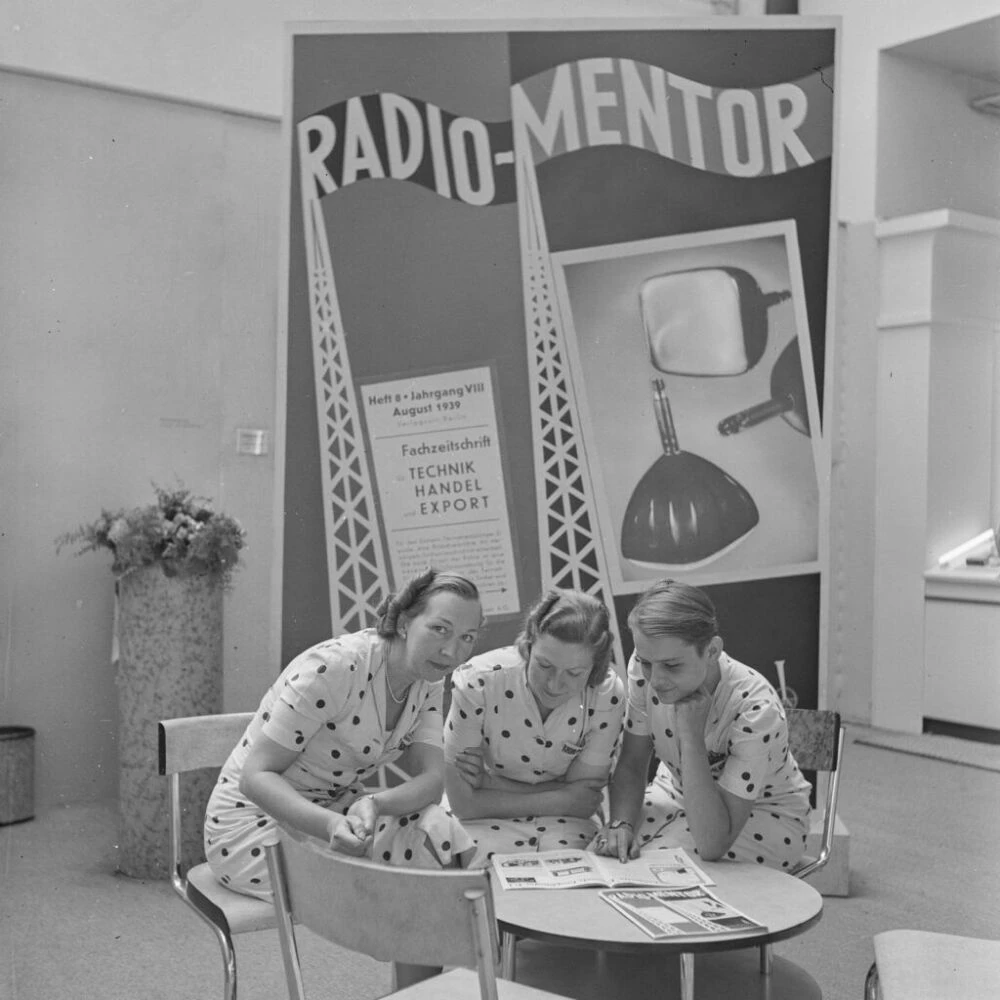IFA History - The years 1934-1949

100 years of IFA: From the "Große Deutsche Funkausstellung" to the world's largest and most important trade fair for consumer electronics and home appliances
IFA, the world's largest and most important trade fair for consumer electronics and home appliances, is celebrating its 100th anniversary this year. IFA was first held in December 1924 as the "Great German Radio Exhibition" in Berlin. Since then, IFA has stood for innovation, technology and entertainment.
To mark this anniversary, the industry organisation gfu Consumer & Home Electronics GmbH, owner of the IFA trademark rights, is reviewing 100 years of technical development in the consumer electronics and household appliance industry. Episode two is dedicated to the years 1934 to 1949.
The first part of the following sections deals with the actual radio exhibition in the respective year, the second part reports on the industry in general.
1934
The 11th "Große Deutsche Funkausstellung" took place from 17 to 26 August. it attracted 235 exhibitors and 325,000 visitors. Thanks to improved technology, it was possible to save one tube for the same output in CRT sets. So-called all-current tubes are absolutely hum-free and safe to operate with alternating and direct current. The manufacture of the people's receiver was demonstrated in the so-called "Hall of Labour". Laboratory demonstrations of the current state of television were shown by the Deutsche Reichspost. Almost all television systems used a Braun tube with 180 lines and 40,000 pixels at 25 frames per second. Television sets for public television parlours were also on display, as well as set-ups for picture transmission in the VHF range.
The German Reichspost broadcast regular television programmes from an FM transmitter in Berlin-Witzleben and the first television parlours were set up. One million Volksempfänger receivers had already been produced. On 1 January 1934, five million radio subscribers were registered. The magnetophone tape for electronic sound recording was developed.
1935
This year, the 12th "Great German Radio Exhibition" was held from 16 to 25 August. The number of exhibitors totalled 234 and the number of visitors was estimated at 500,000. 144 new radio receivers were on display. The variety of housing designs was also remarkable. A tape recorder, the Magnetophon K1, was presented for the first time. A television street was also impressive. However, the event was overshadowed by a catastrophic fire in Hall 4 up to the radio tower restaurant. Almost all the equipment and installations were burnt down.
On 22 March, the Reichs-Rundfunkanstalt opened the world's first public television programme service. On three evenings a week, excerpts from feature films, cultural films and newsreels were shown to around 250 participants from 8 pm to 10 pm. The "Kodachrome" reversal film as 16 mm narrow film is the first colour film.
1936
The 13th "Great German Broadcasting Exhibition" was held from 28 August to 6 September with 170 exhibitors. 350.000 visitors are recorded. The radio exhibition was "characterised by better sound, from technically good to musically beautiful sound". Technically, this was based on new loudspeaker tubes and increased efficiency of the loudspeakers themselves. In addition to record players with an electric pick-up for connection to the existing radio, there were two types of combination units: the chest-shaped table-top unit and the music cabinet. There was also the electronic television camera and TV receiver with 375 picture lines and interlace. A special exhibition showed a telephone station as a video telephone with remote stations in the Berlin city area.
After ten years of development work, the mechanical television method proved to be unsuitable. An Ikonoskop camera transmitted the Olympic Games competitions from the Berlin Olympic Stadium to 28 Berlin television parlours. The first mechanical hoover "New Maid" came onto the market.
1937
307.000 visitors came to the 14th "Great German Broadcasting Exhibition" from 30 July to 8 August. The number of exhibitors was 150. This radio exhibition was characterised by a noticeable price reduction for radio sets, which was made possible by a reduction in the price of tubes that came into force in July. There was a demonstration of colour television pictures.
In January, there were 8.2 million registered radio listeners, the highest number in Europe at the time. Radio sets were getting better and better, and stations were now selected using pushbuttons. The first electromagnetic light pickup with a sapphire permanent needle for record scanning was introduced.
1938
The 15th "Great German Radio Exhibition" attracted 158 exhibitors and 360,000 visitors. It took place from 5 to 21 August. The receivers of the "new season" were characterised by further improvements in sound quality, and devices in the upper price range were more user-friendly. A total of over 210 new radio receivers were exhibited. These included a wide range of devices for reception of three wavebands. These radios are equipped, for example, with a "magic eye" for better tuning and large, clear dials with over 100 station names in some cases. There are devices with a station search function. The announcement that television reception would be permitted from 1 October 1938 gave the exhibition a new look: for the first time, television receivers were on an equal footing with audio broadcasting.
In March, Germany's first fully electronic television studio was completed in the Haus des Rundfunks. In consultation with the industry, a television receiver modelled on the Volksempfänger was to be developed. The so-called shadow mask picture tube was patented, the basis of the later colour picture tubes.
Continue reading here https://gfu.de/ifa-historie-die-jahre-1934-bis-1949/
The history of the IFA can be found at gfu.de/ifa-berlin/100-jahre-ifa/.
Our review does not claim to be exhaustive.
Sources:
The history of consumer electronics, Jochen Wiesinger
70 years of the Funkausstellung, Heide Riedel